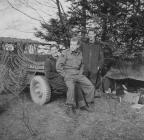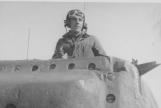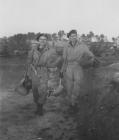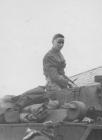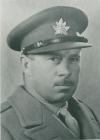41
This is 'A' Squadron's field kitchen during Exercise 'Spartan' in southern England.1943
Marlborough, England, UK
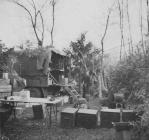
43
Jeeps were so versatile they were used as dead weight in sports events like this one.1943
Somewhere in England, UK

49
This BCD is ready to go somewhere. Maybe another case of 'hurry up and wait.'1943
Somewhere in England, UK

51
In May Lt. Col. Murphy went off to become the Chief of Staff for the Division and later given command of the 1st Canadian Armoured Brigade from February 1944 to wars end. He was replaced each time by an old lime BCD, Lt. Col. H. H. Angle, who was a Militia Capt. before the war.Throughout 1943 the Regiment engaged in exercises on the Brigade level, simulating movements in battle, and ironing our supply and communication problems critical to the efficiency of the unit. Then, in November, following mass inoculations for typhus and malaria, and the issuing of mosquito nets and other tropical kit, the Division was dispatched to the Italian theatre to become part of General Montgomery's famous "Desert Rats," the 8th Army.
In late November the advance parties of the Regiment disembarked in Naples. Owing to difficulties with transport the remainder detoured to North Africa and a camp near Algiers where the men visited the Casbah and other sites of interest until regrouping in Italy in December. They had left their well-maintained vehicles and tanks in England. In Italy they received the cast-off, battle worn and damaged relics of the 8th Army. In their usual good spirits and manner all ranks dealt with the problem in a proper military fashion. When asked to provide vehicles to other units the Regiment passed along the best they had.
During the early months of 1944 the Dragoons trained behind the lines in southern Italy practising tactical manoeuvres with the infantry units in the Division. The next several months saw them stationed in the town of Matera, near Naples, where it was re-equipped with newer vehicles and the new American built Sherman M4A4 tanks. They weighed 35 tons each and were powered by a Chrysler 30 cylinder, multi-bank engine for a maximum speed of 25 mph and a range of 100 miles. Armament consisted of a 75mm main gun, a .50 Calibre Browning Heavy Machine gun, and two .30 Calibre Browning Machine Guns. The Sherman had a five-man crew: Crew commander, Gunner, Loader/Wireless Operator, Driver and Co-driver/hull machine-gunner. Experience was to show that the tanks armour was too thin; many crews welded steel track segments onto the front and sides.
In February 1944 a new war establishment was authorized for the Regiment, which meant a reduction in manpower of 70 all ranks. There would once again be four troops per squadron instead of five. A new wrinkle would be the addition of a 44-man Reconnaissance troop mounted in 11 "Honey" tanks. These were Stuart tanks with the turret and main gun replaced by a heavy machine gun and retaining the hull-mounted light machine gun. These 'recce' tanks would prove very useful in battle.
53
Anti tank obstacle on the Hitler Line in the Liri Valley, Italy.1944
Somewhere in the Liri Valley, Italy

